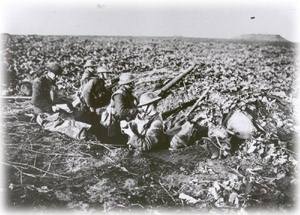Over 35,500 Irish soldiers died in the Great War. Memories of the war and the victims it claimed were still fresh in Irish households. The Ireland to which the veterans returned was a very different place from the home they had left. Many were victimized either physically – the IRA murdered at least two hundred between 1919 – ’22, many of these murders resulting from personal grudges – or economically – the 1919 unemployment ratio of ex-servicemen was 46% in Ireland compared to just 10% in Britain.

Irish soldiers in the trenches at Ginchy.
In 1919, a Trust was founded to fund a permanent memorial to all the Irishmen who had fallen. Some nationalists did oppose a number of proposals and an early scheme to locate a memorial in Merrion Square did not succeed. The present War Memorial Gardens in Dublin, first proposed by a Cosgrave government, was the plan completed under a de Valera administration in 1936.
The poppy, common to many battlefields, was adopted as a symbol of remembrance of those who died in the war, but has since become politicised. Early Remembrance Day commemorations were attended by huge crowds, though Sinn Féin protests did lead to violence. In 1923, 150,000 poppies were sold within a few days in the Irish Free State.
The role of the Irish soldiers from the territory now the Republic, was gradually played down, by both the establishment in the Republic who wanted to distance Ireland from Great Britain, and others preferred not to dwell on the contribution the Irish had made to the war.
Irish National War Memorial Gardens
The War Memorial Gardens are situated on the southern slopes of the Liffey opposite the Magazine Fort in the Phoenix Park. Designed by Sir Edward Lutyens, the gardens were built by a workforce made up of ex-servicemen from both the British and Irish armies. The Memorial is part of a larger, 150 acre park between Islandbridge and Chapelizod.
The committee which proposed building a memorial and established the Irish National War Memorial Trust fund to cover the cost, also erected Memorials to the Irish soldiers at battle-sites in France and Flanders. ‘Ireland’s Memorial Records,’ an eight-volume directory of the names and services of every Irish officer and soldier killed in the Great War was also published. Copies of these records are kept in the book-rooms at the National War Memorial.
Early Remembrance
Around the country, some communities (eg. some schools, Lansdowne Road rugby ground, churches and towns) erected memorials to honour those who had been killed in the First World War. In the early twenties, thousands of people would gather at various centres around the country, such as College Green in Dublin where the Ginchy Cross was temporarily erected each year as an Irish Cenotaph. A two minute silence was observed at 11am. According to ‘The Irish Times,’ 120,00 people attended the College Green commemoration in 1925. The same year, a smoke bomb was let off in the crowd and a film called ‘Ypres,’ stolen from The Masterpiece Cinema in Dublin. Sinn Féin organized annual protests and violence led to the relocation of the commemorations. On the Sunday prior to Remembrance Day, veterans gathered to parade to Requiem Mass at the Pro-Cathedral and later to a service in St. Patrick’s Cathedral. These religious services were attended by the Lord Mayor of Dublin and Foreign Ministers accredited to the Irish Free State. Representatives of the Free State government attended official commemorations in both Dublin and London and in 1938, a Fianna Fáil government sent a wreath of orange flowers and white lilies to the London Cenotaph,
“in memory of the brave.”
The singing of the British national anthem and the display of the Union Jack at these events caused a great deal of distress to participants and Imperialists exploited the occasion as much as extreme Nationalists. Over the years, in the Irish consciousness, the poppy and Remembrance Day have become associated less with respect for those who died in war and wrongly confused with a statement of political allegiance. Recently, some commentators and historians have begun to examine and evaluate the part played by Irish soldiers in the Great War. Some attention is now being given to the sacrifice of the 35,500 Irish people who died during the War, the suffering of the 200,000 who watched their comrades die and the grief of the loved ones who mourned for the lives lost.
Click here to download more about this
Economic & Social Status
Many returning veterans found that they were distrusted by their fellow countrymen because they had served in the British army.
Many men were invalided and of those fit for work (physically at any rate), some did return to their old jobs which had been ‘kept’ for them. Of the 645 Guinness employees who joined up (72 were Royal Dublin Fusiliers), 370 did return to take up their jobs. The army had a scheme whereby ex-servicemen could continue their education. Within a year of the war ending however, 35,000 ex-servicemen in Ireland were receiving an unemployment payment. Some enlisted in the Irish Army, but over 20,000 Irishmen re-enlisted in the British army, whose proportion of Irish-born soldiers in 1921 was as high as in 1913, notwithstanding the War of Independence.
Poor housing, high unemployment and some discrimination in State jobs led to the formation of various Old Comrades Associations to try to relieve the plight of many veterans. A Royal Dublin Fusiliers Old Comrades Association was formed in the late 1920s. Thousands of veterans found that they were ‘surplus to requirements’ and, either unable to find work, or no longer accepted by their community, they emigrated in the hope of a better life abroad.